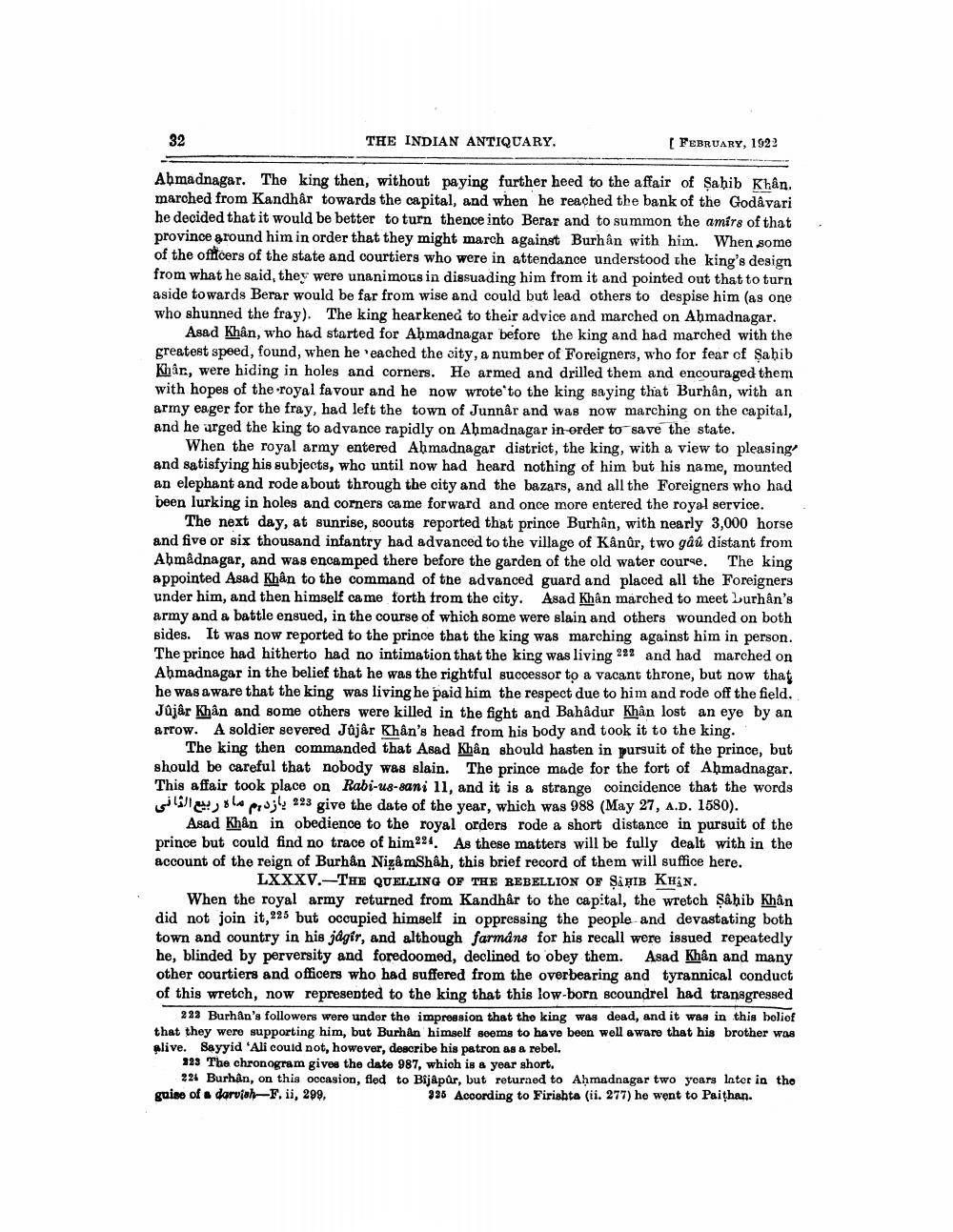________________
32
THE INDIAN ANTIQUARY.
[ FEBRUARY, 1922
Ahmadnagar. The king then, without paying further heed to the affair of Sahib Khân. marched from Kandhår towards the capital, and when he reached the bank of the Godavari he decided that it would be better to turn thence into Berar and to summon the amirs of that province around him in order that they might march against Burhan with him. When some of the offers of the state and courtiers who were in attendance understood the king's design from what he said, they were unanimous in dissuading him from it and pointed out that to turn aside towards Berar would be far from wise and could but lead others to despise him (as one who shunned the fray). The king hearkened to their advice and marched on Ahmadnagar.
Asad Khân, who had started for Ahmadnagar before the king and had marched with the greatest speed, found, when he eached the city, a number of Foreigners, who for fear of Şahib Khár, were hiding in holes and corners. He armed and drilled them and encouraged them with hopes of the royal favour and he now wrote to the king saying that Burhân, with an army eager for the fray, had left the town of Junnâr and was now marching on the capital, and he urged the king to advance rapidly on Ahmadnagar in order to save the state.
When the royal army entered Ahmadnagar district, the king, with a view to pleasing' and satisfying his subjects, who until now had heard nothing of him but his name, mounted an elephant and rode about through the city and the bazars, and all the Foreigners who had been lurking in holes and corners came forward and once more entered the royal service.
The next day, at sunrise, soouts reported that prince Burhan, with nearly 3,000 horse and five or six thousand infantry had advanced to the village of Kânûr, two gâu distant from Ahmadnagar, and was encamped there before the garden of the old water course. The king appointed Asad Khân to the command of the advanced guard and placed all the Foreigners under him, and then himself came forth from the city. Asad Khân marched to meet Lurhan's army and a battle ensued, in the course of which some were slain and others wounded on both sides. It was now reported to the prince that the king was marching against him in person. The prince had hitherto had no intimation that the king was living 222 and had marched on Ahmadnagar in the belief that he was the rightful successor to a vacant throne, but now that he was aware that the king was living he paid him the respect due to him and rode off the field. Jūjar Khan and some others were killed in the fight and Bahadur Khân lost an eye by an arrow. A soldier severed Jâjâr Khan's head from his body and took it to the king.
The king then commanded that Asad Khân should hasten in pursuit of the prince, but should be careful that nobody was slain. The prince made for the fort of Ahmadnagar. This affair took place on Rabi-us-sani 11, and it is a strange coincidence that the words will be proj! 223 give the date of the year, which was 988 (May 27, A.D. 1580).
Asad Khân in obedience to the royal orders rode a short distance in pursuit of the prince but could find no trace of him $24. As these matters will be fully dealt with in the account of the reign of Burhân NizâmShah, this brief record of them will suffice here.
LXXXV.-THE QUELLING OF THE BEBELLION OF SĦIB KHAN. When the royal army returned from Kandhår to the capital, the wretch şahib Khân did not join it,225 but occupied himself in oppressing the people and devastating both town and country in his jagir, and although farmáns for his recall were issued repeatedly he, blinded by perversity and foredoomed, declined to obey them. Asad Khan and many other courtiers and officers who had suffered from the overbearing and tyrannical conduct of this wretch, now represented to the king that this low-born scoundrel had transgressed
222 Burhan's followers were under the impression that the king was dead, and it was in this belief that they were supporting him, but Burhan himself seems to have been well aware that his brother was plive. Sayyid 'Ali could not, however, describe his patron as a rebel.
323 The chronogram gives the date 987, which is a year short.
224 Burhan, on this occasion, fled to Bijâpur, but returned to Ahmadnagar two years later in the guise of a darvish-F. ii, 299,
335 According to Firishta (ii. 277) he went to Paithan.




